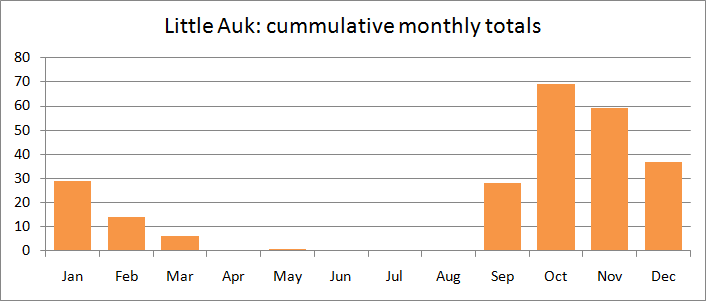Puffin - 1894
 Tuesday, March 1, 2011 at 8:25AM
Tuesday, March 1, 2011 at 8:25AM Species account from M Mathew, 1894, "The Birds of Pembrokeshire and its islands"
 Tuesday, March 1, 2011 at 8:25AM
Tuesday, March 1, 2011 at 8:25AM Species account from M Mathew, 1894, "The Birds of Pembrokeshire and its islands"
 Wednesday, May 12, 2010 at 12:44PM
Wednesday, May 12, 2010 at 12:44PM Alle alle
Occasional visitor.
The Little Auk is a high Arctic bird breeding westward from the Bering Sea to Baffin Island. Wintering areas include the Norwegian Sea, northern North Sea, Iceland and Greenland waters. Migratory and dispersive Little Auks have occurred as far south as France, the Mediterranean, Madeira and the Azores.
Recorded occurrences in Pembrokeshire have increased over time, from 30 occasions between 1880 and 1981 to 137 times between 1982 and 2006. This is most likely a reflection of observer activity rather than a change in status. Most have involved birds being pushed near to shore by strong winds.
The largest incursion may well have been in February 1950, when the West Wales Field Society reported “many washed up dead on the coast”, one was picked up near Haverfordwest on the 11th February and the remains of at least 13 were found on Skokholm when the island was re-occupied in April. These were part of a “wreck” affecting the south west of Britain and Ireland between the 8th and 11th February, following powerful south west winds.
Subsequent records have related to very small numbers, 75% involving sightings of single birds but eight were noted on the 1st October 1995, 13 on 24th September 1995 and 21 on 20th November 1983. Mostly live birds, but some dead or moribund, have been recorded at many places around the coast from Amroth in the south to Newport Bay in the north. They have also been recorded from the offshore islands of Ramsey, Skomer and Skokholm and further out to sea around The Smalls. Singles have been found beyond the outer coast at Fishguard Harbour, the Gann/Dale, Angle Bay, Pembroke, Haverfordwest , Keeston, Walwyn’s Castle, Clarbeston and Trecwn.
Cumulative totals by month of occurrence.
 The earliest date recorded was of one passing Strumble Head on the 10th September 1987, the latest one at St Govans’s Head on the 30th May 1983. The majority (79 %) recorded between 1983 and 2006 were from Strumble Head, reflecting the intensity of seawatching at that locality.
The earliest date recorded was of one passing Strumble Head on the 10th September 1987, the latest one at St Govans’s Head on the 30th May 1983. The majority (79 %) recorded between 1983 and 2006 were from Strumble Head, reflecting the intensity of seawatching at that locality.
Occurrences on the west coast of Britain seem to bear no relationship to the not infrequent “wrecks” of large numbers along English North Sea shores. The Norwegian Sea into the North Sea, almost south to the Dogger Bank, is a major wintering area and prolonged strong winds from the north could be expected to push Little Auks further south into the funnel shaped southern North Sea. Such winds would be unlikely to result in a westerly displacement of these birds into the Atlantic but might well affect birds wintering in the Iceland and Greenland sea-area. These would find themselves pushed into the wide Atlantic where they could conceivably become dispersed, or if still concentrated to any degree be a long way from land. Subsequent strong westerlies could push some of these into Irish and western British waters but events documented so far suggests that, with no known concentrations in adjacent areas, would result in small numbers being involved. The largest numbers involved, as in 1950, were small compared to southern North Sea incursions. It also seems relevant that birds reaching the south western area would have travelled over four times the distance from known wintering areas than those in the southern North Sea would.
Graham Rees
 Auk,
Auk,  GHR,
GHR,  winter in
winter in  Little Auk
Little Auk